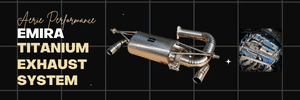Let's dive in on the braking system a bit! The Evora GT uses very similar brakes, unknown whether they are identical but the geometry is equivalent. AP Racing 4 pots, 370mm front / 350mm rear.
Assuming the whole system is similar on the Emira to what they did on the updated/recent Evora variants, the performance should be absolutely excellent for a factory braking system. It's totally unknown whether the system is the exact same or not, but Lotus do tend to standardize where possible between models so there's a good chance the late model Evora GT fitment might be carried over.
AP Racing uses a standardized system for their brake part numbers, so we can do some sleuthing.
View attachment 3927
2021 Evora GT/GT410/etc front brake pads are Lotus part number A132J0326S. The part number printed directly on the pad is AP Racing 356 CP7040X61BX-DS25HP. Image:
View attachment 3921
That's an AP Racing
CP7040D61-type pad profile. The section at the end is the friction compound. In this case DS25HP indicates that it's the Ferodo DS2500HP, which is sometimes called DS2500+, a variant of the DS2500 compound for street applications in heavier vehicles (i.e. not superlight).
View attachment 3923
AP Racing offers this aftermarket in their own APF405 compound, Ferodo DS2500, Ferodo DS2500HP, Ferodo DS3000, Pagid RS29, Raybestos ST45, and Raybestos ST47.
The rear pad for the same car (2021 Evora GT) is Lotus part number A132J0001S, which is printed on the pad as AP Racing 420 CP6600X55BX-DS25HP, so it's a similar configuration to the front pad but in a slightly smaller geometry to suit the smaller rear rotor.
View attachment 3925
View attachment 3924
AP Racing offers this aftermarket in their own APF404 compound, Ferodo DS2500, Ferodo DS3000, and Pagid RS14B. Lotus likely has the pad made for them in the DS2500HP compound to match the fronts.
There is a ton of information available in the
AP Racing catalog in the Brake Pads section about all of these compounds, about the available variations of AP's own pads in this particular shape (profile), and a wealth of technical data.
This same pad geometry is also available directly from other brake vendors (Hawk, EBC, Carbotech, etc) in a variety of different compounds to suit particular applications.
All this is simply to say... for those who want something different from the factory pad for a race or track-day application, there's a whole world of race-oriented pads available, for those who want to gain outright performance at significant cost to noise and/or dust. Almost all "factory" pads make a necessary compromise in raw performance to gain quiet and low-dust operation for daily usability in the real world, and I expect the Emira to be no different. Brakes are naturally very noisy, and the engineering needed to make them livable and comfortable while also performing well in a range of conditions is very, very difficult.
Warning/caveat: High performance street/trackday brake pads are notoriously annoying to live with on the street, so I discourage experimentation if you aren't prepared for the compromise. Also, the most aggressive race pads that provide extreme performance usually require significant heat before full friction behavior and should
never be used on public roads, because they are essentially unusable in the cold after first setting off, and WILL result in a collision or other incident that could lead to injury or death. Please be safe and smart.
Hope some of this helps someone down the line.







